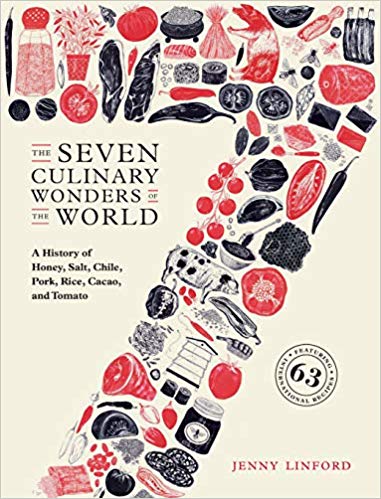
The Seven Culinary Wonders of the World: A History of Honey, Salt, Chile, Pork, Cacao, and Tomato
Tom Verde
Jenny Linford
2018, Smithsonian Books, 9-781-58834-6-421, $27.95 hb.
Humankind’s relationship with the seven ingredients so diligently and informatively explored in this cookbook is “a long one, developed over thousands of years,” to the extent that they “have acquired cultural and religious values.” With these pedigrees in mind, food writer Jenny Linford reaches back into the histories of each ingredient, advising that none should be taken for granted. Images of honey-gathering adorn caves in Valencia, Spain, occupied in prehistoric times, as well as the walls of temples in Egypt where “we come across the first records of beekeeping or apiculture.” Those same Egyptians relied on salt “medicinally to dry out and disinfect wounds.” Rice had a long journey from India and China, reaching the Middle East around 1000 BCE, and was introduced to Europe by Arabs through southern Spain. It forms the foundation of Middle Eastern mejadra (rice and lentils), one of 62 recipes in this thoughtfully curated culinary history.
You may also be interested in...

Noorjahan Bose: A Life of Learning
Taking inspiration from her now-deceased mother, Noorjahan Bose, a daughter of the Agunmukha, Bangladesh, now shifts her energy toward empowering other daughters.Celebrate Women's History Month With These Reads on Women Throughout History
To help honor Women’s History Month, AramcoWorld brings you a list of 10 female-focused reads that celebrate women throughout history.
Drawing New Conclusions About the Status of Women in Ancient Egypt
Egyptologist Mariam F. Ayad that gender bias among historians accounts for an underrepresentation of women’s lives in historical studies of Egypt.